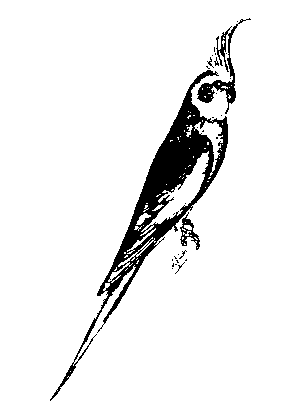The ACS Standard of Perfection ©

General Conformation
The Cockatiel is a long bird, with graceful proportions, but of good substance (full bodied). From the top of the shoulder curve to the tip of the wing, from the top of the skull to the vent and from the vent to the tip of the tail (ideally) should measure 7". The goal being a 14" bird with a 3" crest. The total bird being 17 inches.
Crest
Should be long (goal 3"),with good density, curving from the top of the cere fanning out to give fullness.
Head
Should be large and well rounded with no flat spot on top or back of the skull. Baldness will be faulted according to the degree of severity of each bird on the show bench. Our aim is for no bald spot, even in Lutinos. The eyes should be large, bright and alert, and placed at mid-point between front and back of the skull. The brow should be well pronounced when viewed from the front, the brow should protrude enough to indicate good breadth between the eyes. The beak should be clean, of normal length, and tucked in so the lower mandible is partially visible. Cheek patches should be uniformly rounded, well defined, (no bleeding), and brightly colored (especially on the males). Adult male Cockatiels will have a bright, clear, yellow head, sharply defined where the yellow meets the border of the main body feathers. A deep bib is preferred. There should be no evidence of pin feathers.
Neck
Should be relatively long- have a very slight curvature above the shoulders and have a small nip above the chest area, giving the bird a graceful outline and eliminating the appearance of a "bull" neck or the "ramrod" posture of some psittacine species. An exaggerated "snake" neck would be reason for fault.
Body
The body of the Cockatiel when viewed strictly from the side angle can be somewhat deceptive, as only a well rounded outline of the chest will indicate whether the specimen has good substance. A frontal (or back) view shows more truly the great breadth through the chest (and shoulder) areas of an adult Cockatiel (more prevalent in hens). It is the strong muscular development that enables the Cockatiel to be such a strong flier. A Cockatiel should have a high. broad. full chest (more prevalent in hens), a slender, tapering abdomen, a wide, straight back (no hump or sway), and be a large, sleek bird.
Wings
Should be large, wide and long, enveloping most of the body from a side view. Should he held tightly to the body,. tips close to the tail with no drooping of the shoulders or crossing of the wings. The wing patch should be wide (goal of 3/4" at the widest point), well defined and clear of darker feathers. All flight feathers should be in evidence. Covert feathers should illustrate their growth pattern clearly.
Legs and Feet
Should hold the bird erect at approximately 70 degrees off the horizontal. Must grasp the perch firmly (two toes forward and two back), be clean, and claws not overgrown or missing.
Tail
The longest flights should be the extension of an imaginary line straight through the center of the bird's body. A humped back will cause the tail to sag too low, and a "swayed" back might elevate the tail higher than desired. The feathers themselves should be straight clean and neither frayed, split or otherwise out of line. All flights should be in evidence.
Condition
A bird in top condition has clean, tight feathers: no frayed or missing feathers, no half grown or pin feathers. The beak and claws must be of suitable length. There should be no unnatural roughness or scaling on the cere, beak, legs or feel. If a bird is in good condition, it will be almost impossible to get it wet. Water will roll off like it does off a duck.
Deportment
In a good show stance, the exhibition Cockatiel should indicate a central line approximately 70 degrees off the horizontal. The bird will present and display well on the perch.